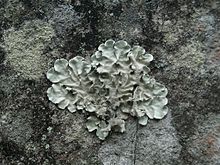Species of lichen
| Parmotrema tinctorum | |
|---|---|

| |
| Conservation status | |
 Secure (NatureServe) | |
| Scientific classification | |
| Domain: | Eukaryota |
| Kingdom: | Fungi |
| Division: | Ascomycota |
| Class: | Lecanoromycetes |
| Order: | Lecanorales |
| Family: | Parmeliaceae |
| Genus: | Parmotrema |
| Species: | P. tinctorum |
| Binomial name | |
| Parmotrema tinctorum Hale 1974 | |
Parmotrema tinctorum is a lichen which belongs to the Parmotrema genus. The lichen is as known as the Palm Ruffle Lichen and is listed as secure by the Nature Conservatory.
Description
Grows to around 3–30 cm in diameter with board dull smooth slightly shiny gray lobes that are 10–20 mm wide. The underside is black with naked brown areas with a central collection of simple rhizines.
Habitat and range
Global distribution with a majority of samples being located in North America and Europe.
Chemistry
Compounds derived from Parmotrema tinctorum have been found to have anti-cancer properties.
Environmental monitoring
Parmotrema tinctorum has been identified and used as a candidate for monitoring air pollution.
See also
References
- ^ "NatureServe Explorer – Parmotrema tinctorum". NatureServe Explorer Parmotrema tinctorum. NatureServe. 24 August 2022. Retrieved 24 August 2022.
- "CNALH – Parmotrema tinctorum". lichenportal.org. Retrieved 24 August 2022.
- Bungartz, Frank; Spielmann, Adriano A. (1 December 2019). "The genus Parmotrema (Parmeliaceae, lecanoromycetes) in the Galapagos Islands". Plant and Fungal Systematics. 64 (2): 173–231. doi:10.2478/pfs-2019-0018. ISSN 2657-5000. S2CID 210075798.
- "Parmotrema tinctorum (Despr. ex Nyl.) Hale". www.gbif.org. Retrieved 24 August 2022.
- Bhaktavalsala Suresh, Ashrini; Kilingar Nadumane, Varalakshmi (2021). "The metabolite 5-methyl-1,3-benzenediol and its derivative methyl-2,4-dihydroxy-6-methylbenzoate from the lichen Parmotrema tinctorum with potent apoptotic and anti-angiogenesis effects". 3 Biotech. 11 (7): 346. doi:10.1007/s13205-021-02883-9. ISSN 2190-572X. PMC 8212346. PMID 34178568.
- Viana, Camila de O.; Vaz, Raissa P.; Cano, Abraham; Santos, Adelina P.; Cançado, Luiz G.; Ladeira, Luiz O.; Junior, Ary Corrêa (2015). "Physiological changes of the lichen Parmotrema tinctorum as result of carbon nanotubes exposition". Ecotoxicology and Environmental Safety. 120: 110–116. doi:10.1016/j.ecoenv.2015.05.034. PMID 26057077.
- Palharini, Kelly Maria Zanuzzi; Vitorino, Luciana Cristina; Bessa, Layara Alexandre; de Carvalho Vasconcelos Filho, Sebastião; Silva, Fabiano Guimarães (2021). "Parmotrema tinctorum as an indicator of edge effect and air quality in forested areas bordered by intensive agriculture". Environmental Science and Pollution Research. 28 (48): 68997–69011. doi:10.1007/s11356-021-15411-2. ISSN 0944-1344. PMID 34286433. S2CID 236146509.
- Boonpeng, Chaiwat; Polyiam, Wetchasart; Sriviboon, Chutima; Sangiamdee, Duangkamon; Watthana, Santi; Nimis, Pier Luigi; Boonpragob, Kansri (2017). "Airborne trace elements near a petrochemical industrial complex in Thailand assessed by the lichen Parmotrema tinctorum (Despr. ex Nyl.) Hale". Environmental Science and Pollution Research. 24 (13): 12393–12404. doi:10.1007/s11356-017-8893-9. hdl:11368/2902076. ISSN 0944-1344. PMID 28357804. S2CID 46159402.
| Taxon identifiers | |
|---|---|
| Parmotrema tinctorum |
|
| Parmelia tinctorum | |
This fungus-related article is a stub. You can help Misplaced Pages by expanding it. |